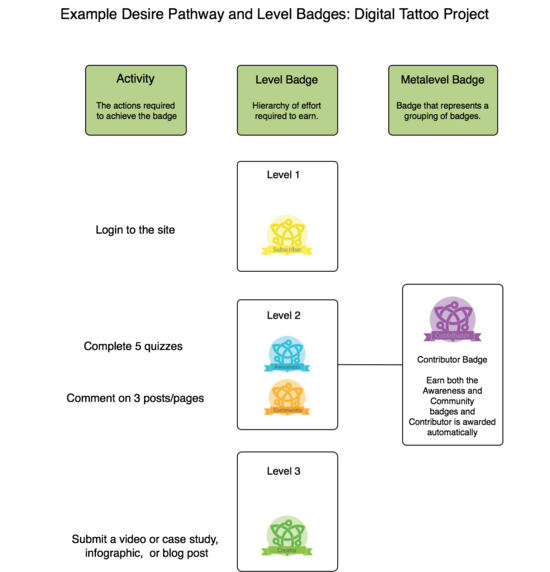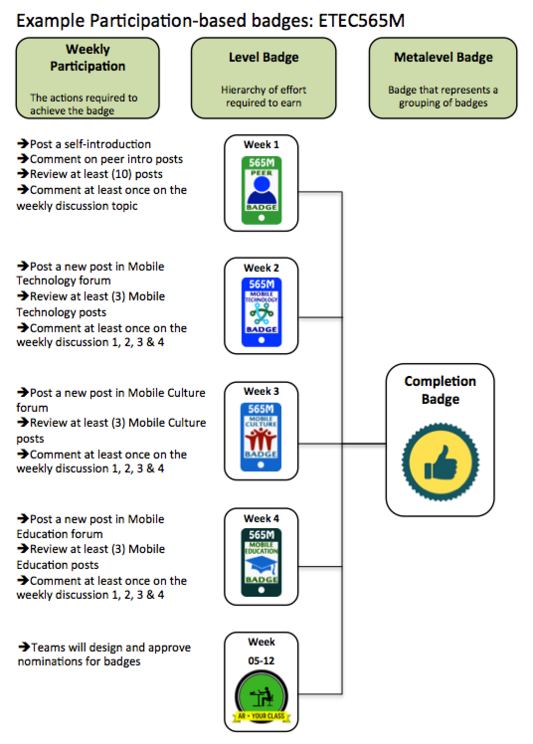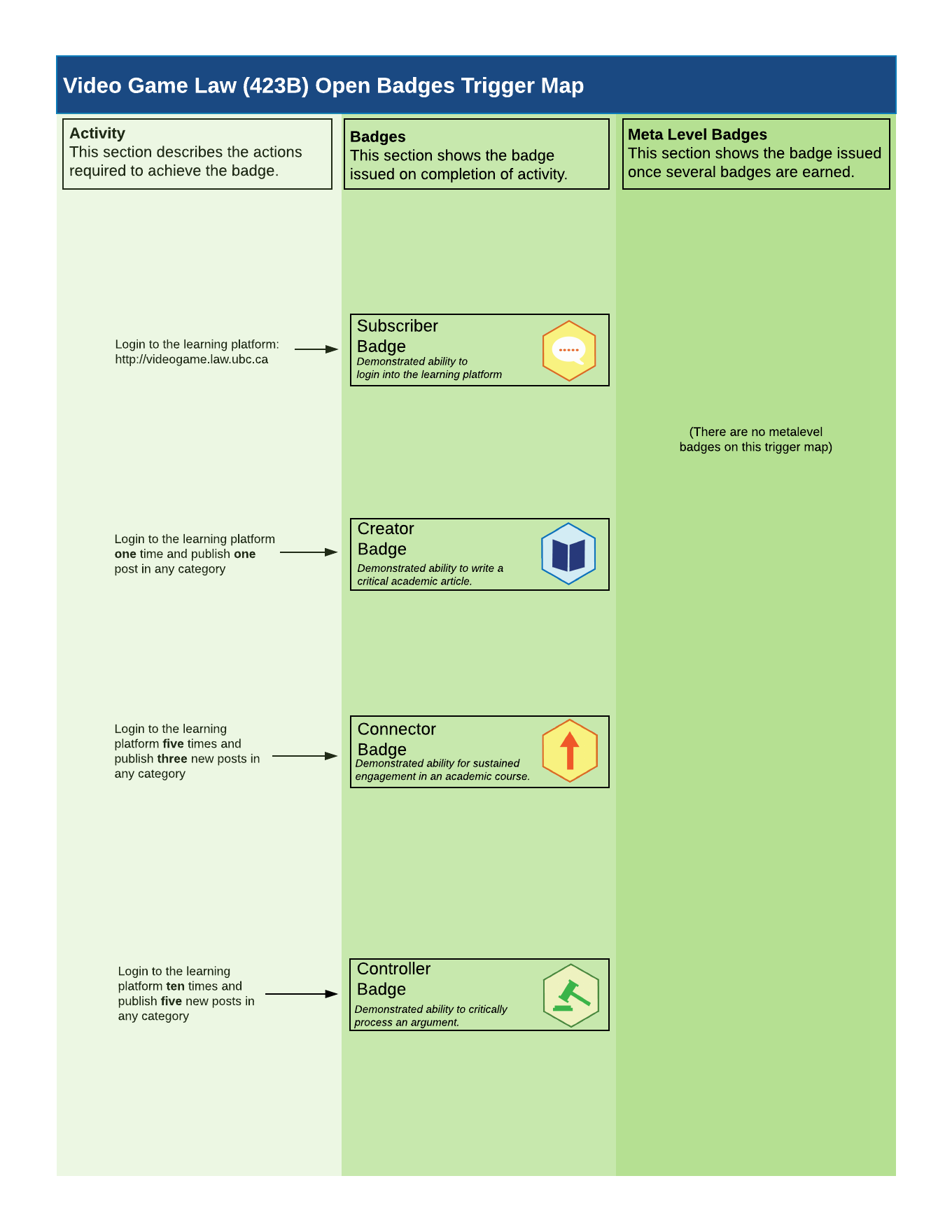Documentation:OpenBadges/Faculty Guide/Web Design/Plan/Learning Pathway
What is a Learning Pathway?
Learning pathways may be thought of as the steps or experiences learners engage in to achieve a desired competency , skill or level of contribution to a community. These pathways may be thought of as prescriptive (recommending a standard or specific pathway in order to achieve a credential) or descriptive (essentially defined by the learner, who will choose a path to follow in order to demonstrate a particular competency). Doug Belshaw, in his post Learning Pathways: Descriptive or Prescriptive? describes the value in each approach like this: "prescriptive pathways tend to score higher on traditional conceptions of 'rigour' (more on that here) while descriptive pathways provide opportunities for interest-based, just-in-time learning." He makes the point that these approaches (taken together) may allow for a powerful learning experience that takes into account motivation, flexibility and external perceptions of rigour, which is important in assessing the value of a badge.
Hive Toronto is developing a series of privacy badges and associated learning activities for youth. They are beginning to imagine some of their badge pathways as either linear, which aligns with the prescriptive pathway described above, or clustered, which aligns with the descriptive approach.


Learning pathways designed with linear progression have the advantage of being clear and easy to follow for learners, but they don't allow for much flexibility in terms of learner choice.
A learning pathway that clusters badges around a particular theme, allows for learner choice and flexibility in terms of which badges to earn in which order and for what purpose, however the downside may be confusion for badge "viewers".
Either way, you'll need to do some thinking about the learning you intend to represent with your badges, the value that representation may have for your learners and for the community, and the context for earning the badges (earned within a course, across a group of courses, in a community setting or work placement or other). Closely associated with the development of badge pathways is the design of your badge system.
- Doug Belshaw (2015): Learning Pathways: Descriptive or Prescriptive?
- Erin Knight (2012): Three T's of Badge System Design
Learning Pathway Structure
Learning pathways for badging is a growing area and will emerge through the process of defining and developing a badging structure. Badge learning pathways provide people the ability to choose the path of their learning based on their own, “personal agency, to define steps that may seem more like hops, and to think about ways to do things that aren’t sequential or even seemingly rational.” While some badge pathways allow for a great deal of learner autonomy, selecting their own connections between their learning and badge acquisition, other pathways can be more defined. The following outlines the types of learning pathways, developed by Carla Casilli.

Command Pathway
Content will affect how badges are related to one another. In a command pathway, the educator sets the order in which the badges must be earned, and there are no optional badges. The command pathway is ideal for content that must be learned in a particular order. For example, as it is best to learn addition before multiplication, a command pathway ensures the addition badge precedes the multiplication badge.
Contract Pathway
In a contract pathway, the learner determines the order of the badges. They decide this order before they begin, and are not allowed to deviate from their path in the process of earning the badges.
Desire Pathway
A desire pathway is similarly decided by the learner, but they decide which new badge to earn upon completion of each badge. If your badged learning units do not presuppose prior knowledge on the part of the student, a contract or desire pathway may work for you.
There is also a middle ground between command and contract/desire pathways. For example, you might determine that several badges must be earned at the beginning of a course, and let students construct their own pathway through the remaining badges.
- Doug Belshaw (2015): Learning Pathways: Descriptive or Prescriptive?
- Carla Casilli Badge Pathways
- Using Badges to Quantify Learning Outcomes at UC Davis/ Courtney Bell - edcetera
- Harris, R., Rainey, L., & Summer, R. (2006). Crazy Paving or Stepping Stones: Learning pathways within and between vocational education and training and higher education. NCVER, Adelaide.
Participation-based badges
Participation-based badges can have a variety of meanings in a course or project. The level of participation needs to be clarified before deciding how the activity will be assessed.

Low-level participation
Low-level participation badges are not referring to any particular competency or skills but are instead issued for becoming a part of the program or community. This could be simply creating an account or viewing pages. This kind of participation is minimal and requires very little knowledge or time from the participant.
High-level participation
High-level participation badges are issued when a participant is not only a part of the community but is an active and engaged member. For example, the University of Indiana’s open online course on educational assessment issues badges when participants make an on-topic contribution to an online discussion. In doing so, the student is implicitly demonstrating they have relevant knowledge but also are engaged in the learning within the environment.
Skill-based badges
Skill-based badging indicates the badge earner's level of competency and ability to demonstrate a learned skill.
Hard Skills
Some credentials are issued when the student devotes a certain number of hours to a task. By contrast, badges are issued when the applicant demonstrates competency. For this reason, many of the badges currently on offer reflect skills that can be easily measured, also known as hard skills. An example of a hard skill is writing a function in a programming language. If the badge applicant is able to write that function, they qualify for the badge.
Soft Skills
Soft skills are generally less tangible than hard skills, which can make assessment difficult. For example, the University of California at Davis issues badges for soft skills like Interpersonal Communication. To better help educators assess students, these soft skills are clearly defined in practical terms. For example, to earn the Interpersonal Communication badge, students “work in collaborative teams, present information for varied contexts and audiences, negotiate approaches and viewpoints and take leadership roles on important issues.”
Because soft skills are more difficult to measure they will affect your approach to assessment.
Badging and Levels
Metalevel Badges
A metalevel badge represents several badges. For example, a student might earn one badge for taking care of cats, another for taking care of dogs, and a third for taking care of birds. When all three badges have been earned, the student is automatically awarded a metalevel badge for the broader concept of taking care of pets.
Level Badges
A leveled badging system places badges into an explicit hierarchy. For example, a leveled badging system might include badges called Videographer 1, Videographer 2, and Videographer 3, with each badge representing an increasing mastery of videography. This increasing level of difficulty makes the leveled badging system distinct from the metalevel badging system.
There are several advantages of the metalevel and leveled badging programs. Metalevel and leveled badging systems offer an incentive to learners who wish to be recognized for a higher level of accomplishment by giving them a icon that signifies this higher level of accomplishment. A tiered system of badges can concentrate the student’s efforts into one topic, which deepens their knowledge. Additionally, a higher-order badge subsumes several badges and thus reduces the total number of badges a student will present. This decreases the possibility of information overload for the viewer of the badge.
Example of a Learning Pathway
This example of a learning pathway was developed to support the pilot project course in Video Game Law.
